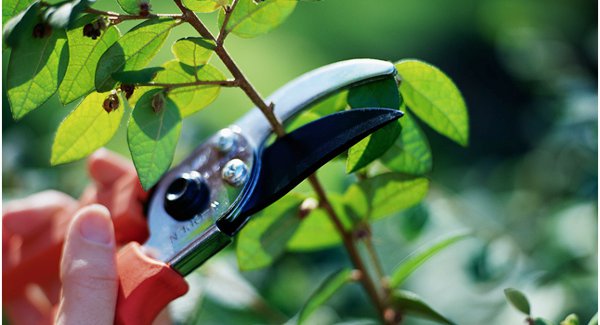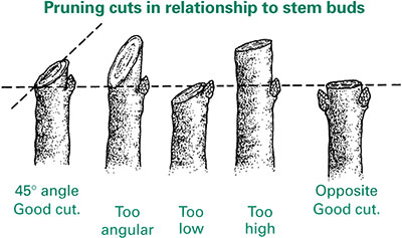As the seasons start to change, so do the outdoor tasks around our yards, and fall is the perfect time to prune back your landscape plants. If you’re new to pruning, it can be a little intimidating – after all, you don’t want to damage your tree or plant. But, proper fall pruning is critical for establishing healthy-looking plants and maintaining an attractive landscape.
To get you started, we’ve gathered some advice to help you prune like a pro, no matter how new you are with the shears.
 The right equipment will make your job easier and protect the long-term health of the tree. Clean cuts heal well, while rough, jagged cuts make the plant more susceptible to disease.
The right equipment will make your job easier and protect the long-term health of the tree. Clean cuts heal well, while rough, jagged cuts make the plant more susceptible to disease.
 When pruning a branch with buds that alternate along the length, cut above the growth bud at a 45 degree angle, make sure the cut’s lowest point is opposite the bud and even with it and the highest point about 1/4 inch above the bud.
Pruning a branch with buds that grow opposite each other in pairs, call for a flat cut above the buds.
When pruning larger limbs (2″ diameter or more), there is a technique involving a series of three cuts that will prevent damage to the tree as the limbs fall.
When pruning a branch with buds that alternate along the length, cut above the growth bud at a 45 degree angle, make sure the cut’s lowest point is opposite the bud and even with it and the highest point about 1/4 inch above the bud.
Pruning a branch with buds that grow opposite each other in pairs, call for a flat cut above the buds.
When pruning larger limbs (2″ diameter or more), there is a technique involving a series of three cuts that will prevent damage to the tree as the limbs fall.
Proper tools
 The right equipment will make your job easier and protect the long-term health of the tree. Clean cuts heal well, while rough, jagged cuts make the plant more susceptible to disease.
The right equipment will make your job easier and protect the long-term health of the tree. Clean cuts heal well, while rough, jagged cuts make the plant more susceptible to disease.
- For twigs and branches 1 inch or less in diameter: A good pair of sharp pruning shears is best for cutting smaller twigs and branches. Bypass pruners make clean cuts and are usually small enough to maneuver easily, making these the most popular choice. Keeping your pruning shears sharp is key to not injury your plants.
- For branches between 1 to 2.5 inches in diameter: A pair of loppers is recommended. Loppers have long handles that provide more reach, perfect for getting to the center of larger trees and shrubs.
- For branches larger than 2.5 inches in diameter: A hand pruning saw works best for these bigger jobs. The saw will make a clean cut that will heal nicely. Make sure you choose a saw large enough for the branches you want to cut.
Proper technique
Here are some pruning dos and don’ts that will make sure you’re helping and not harming your tree or plant:- Prune up to 25% of branches, all the way around. This type of pruning will promote dense growth on most trees and shrubs. You should never remove more than one third of the total branches or more than one third of the crown. It is ok to remove a whole branch if it is damaged or infected.
- It’s a good idea to sterilize your pruners or saw after every cut. You can do this with a solution of 1:1 bleach and water. Using tree paint to seal a wound is not necessary, and often not recommended.
- Prune most deciduous trees while the tree is dormant. Which is any time after the leaves have dropped in the fall and throughout early spring, before there are signs of new growth.
- Maple and birch should be pruned during the summer while there is less sap to seep out.
- Evergreens shouldn’t be pruned in the fall. Instead, prune evergreens in late spring to early summer after new growth has started – mid-June is usually best.
- For fruit-bearing trees, do not be prune all the way around. As mentioned earlier, this type of pruning promotes denseness, which in this case will inhibit fruit production. Fruit trees should be thinned to allow sun exposure and air circulation, resulting in the best crop possible. Suckers that are growing from the base of the tree or around the trunk should also be removed, as they will steal energy from fruit production.
- Prune spring-flowering bushes and shrubs such as lilacs as soon as flowers fade in the spring. These kinds of plants flower on old growth, so pruning at this time will give the plant time to produce new flower buds before next spring. If you prune in the fall, you might not have flowers the following spring.
Pruning Large or Heavy Branches
 When pruning a branch with buds that alternate along the length, cut above the growth bud at a 45 degree angle, make sure the cut’s lowest point is opposite the bud and even with it and the highest point about 1/4 inch above the bud.
Pruning a branch with buds that grow opposite each other in pairs, call for a flat cut above the buds.
When pruning larger limbs (2″ diameter or more), there is a technique involving a series of three cuts that will prevent damage to the tree as the limbs fall.
When pruning a branch with buds that alternate along the length, cut above the growth bud at a 45 degree angle, make sure the cut’s lowest point is opposite the bud and even with it and the highest point about 1/4 inch above the bud.
Pruning a branch with buds that grow opposite each other in pairs, call for a flat cut above the buds.
When pruning larger limbs (2″ diameter or more), there is a technique involving a series of three cuts that will prevent damage to the tree as the limbs fall.
We’re here to help!
If you still have questions about fall pruning for your particular plants or trees, we’re happy to offer you some advice! Just get in touch with our gardening experts, or come see us in person. And now that you’ve started thinking about fall gardening, take a look at our printable Fall Gardening Checklist to make sure you’re ready to start settling your yard in for another fall and winter.Don’t be intimidated by pruning – you’ve got this!
